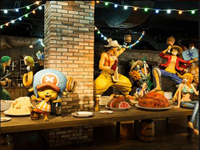Suwa Taisha


(Source: ttypic)
Origin of Faith in Suwa: Kamisha-honmiya
Located south of Suwa Lake, Kamisha-honmiya is said to be the origin of faith in Suwa. Suwa-zukuri is an architectural style that has no honden (the most sacred building that enshrines god), and it features Shikyaku-mon (four-legged gate) that Ieyasu Tokugawa donated and many other existing important cultural properties.

(Source: pixta)
Still Shrouded in Mystery: Onbashira
There are four Onbashira (pillars) surrounding the main shrine. Changed every 7 years, there are various explanations as for the purpose of the four columns, which is still shrouded in mystery. Nonetheless, once you see it right there, you can feel it as a sanctuary area with all your senses.

(Source: Haya_BS )
Shimosha-akimiya (Lower Autumn Shrine)
Heihaiden, a national important cultural property, has the exquisite sculptural decoration, which is a must to see. It also features Neiri-no-sugi, an 800-year-old Japanese cedar that is said to snort in the middle of the night, the biggest, 1.7 meter in length, bronze "komainu (shrine dogs)" in Japan, and "Chozuya (water-filled basin to purify hands before worship)" that is a hot spring. A lot to see!

(Source: pixta)
Great Shimenawa on Kaguraden
Kaguraden in Shimosha-akimiya has the great Shimenawa (enclosing rope). It means a sanctuary on the other side to remove negative vibes and invite God. If the rope is wound up from the right, it is meant to prevent the impure from entering. It is the biggest in Japan and its size is as big as Izumo Taisha in Shimane Prefecture, which is 7.5 meter in length, 4.5 meter round at its thickest, 1 ton in weight. It is massive to show its presence and is an important cultural property.

(Source: eocities)
Onbashira-sai
The Onbashira Festival is the biggest event in Suwa Taisha, which is held every 6 years. Teams of men drag down by themselves the 16 fir logs, which are each 17 meter in height, 1 meter in diameter, and 13 tons in weight, without using any vehicles or other tools. Some of them are brave enough to ride the logs down the steep hill and wade in a river to carry them. It is famous as a bold and boisterous event. About 200,000 people come to this festival, and it becomes a popular topic in the year of the festival.

(Source: pixta)

(Source: ttypic)
Origin of Faith in Suwa: Kamisha-honmiya
Located south of Suwa Lake, Kamisha-honmiya is said to be the origin of faith in Suwa. Suwa-zukuri is an architectural style that has no honden (the most sacred building that enshrines god), and it features Shikyaku-mon (four-legged gate) that Ieyasu Tokugawa donated and many other existing important cultural properties.

(Source: pixta)
Still Shrouded in Mystery: Onbashira
There are four Onbashira (pillars) surrounding the main shrine. Changed every 7 years, there are various explanations as for the purpose of the four columns, which is still shrouded in mystery. Nonetheless, once you see it right there, you can feel it as a sanctuary area with all your senses.

(Source: Haya_BS )
Shimosha-akimiya (Lower Autumn Shrine)
Heihaiden, a national important cultural property, has the exquisite sculptural decoration, which is a must to see. It also features Neiri-no-sugi, an 800-year-old Japanese cedar that is said to snort in the middle of the night, the biggest, 1.7 meter in length, bronze "komainu (shrine dogs)" in Japan, and "Chozuya (water-filled basin to purify hands before worship)" that is a hot spring. A lot to see!

(Source: pixta)
Great Shimenawa on Kaguraden
Kaguraden in Shimosha-akimiya has the great Shimenawa (enclosing rope). It means a sanctuary on the other side to remove negative vibes and invite God. If the rope is wound up from the right, it is meant to prevent the impure from entering. It is the biggest in Japan and its size is as big as Izumo Taisha in Shimane Prefecture, which is 7.5 meter in length, 4.5 meter round at its thickest, 1 ton in weight. It is massive to show its presence and is an important cultural property.

(Source: eocities)
Onbashira-sai
The Onbashira Festival is the biggest event in Suwa Taisha, which is held every 6 years. Teams of men drag down by themselves the 16 fir logs, which are each 17 meter in height, 1 meter in diameter, and 13 tons in weight, without using any vehicles or other tools. Some of them are brave enough to ride the logs down the steep hill and wade in a river to carry them. It is famous as a bold and boisterous event. About 200,000 people come to this festival, and it becomes a popular topic in the year of the festival.

(Source: pixta)






